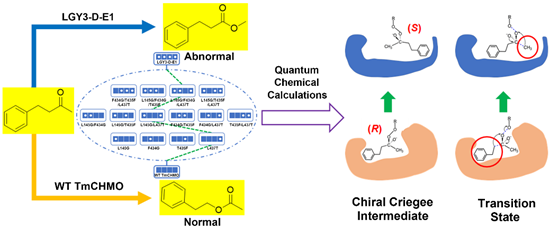IPPCAAS Scientists Uncovered the Regioselectivity of a Baeyer-Villiger Monooxygenase in Microbial Metabolic Pathway
Recently, scientists from the Innovation Team for Biological Control of Plant Diseases at IPPCAAS, in cooperation with Chinese Academy of Sciences, and Max-Planck-Institut für Kohlenforschung, Germany, have published an article in ACS Catalysis titled “Biocatalytic Baeyer-Villiger Reactions: Uncovering the Source of Regioselectivity at Each Evolutionary Stage of a Mutant with Scrutiny of Fleeting Chiral Intermediates”. In this paper, the authors uncovered the regioselectivity of a Baeyer-Villiger monooxygenases (BVMOs) in microbial metabolic pathways.
Baeyer-Villiger monooxygenases are widely involved in biosynthesis and biotransformation of microbial secondary metabolites and natural products. Directed evolution of enzymes provides a means to create microbial metabolite pesticides by improving the yield of target metabolites, or changing the structure of target metabolites to enhance their activity. In our previous work, we addressed the problem of switching regioselectivity of a Baeyer-Villiger monooxygenase (BVMO) using linear ketones as substrates (J. Am. Chem. Soc. 2018, 140, 10464-10472). However, the mechanism of controlling regioselectivity remains unexplored.
In this study, we reported the discovery of unexpected mechanistic intricacies of Baeyer-Villiger monooxygenases catalyzing oxidation of linear ketone 4-phenyl-2-butanone. We firstly constructed all possible mutants of variant LGY3-D-E1, namely all potential combinations based on the four point-mutations. The catalytic activity and free energy values of all mutants were tested in the Baeyer-Villiger oxidation of linear ketone 4-phenyl-2-butanone. Upon systematically exploring the cooperative or antagonistic interactions of different mutations, we chose one favored pathway to reveal the mechanism of controlling the electronic effects. Then we tried to solve the crystal structures of four mutants in the favored pathway, and only the crystals of variant L437T were successfully obtained. Based on the X-ray structural data, we unraveled the inversion of the regioselectivity by employing quantum chemical (QM) analyses at all evolutionary stages. It is noteworthy that different mutations affect regioselectivity of the reaction by switching the enantiopreference of the Crigee intermediate in the evolutionary pathway. Our results lay a solid foundation for future directed evolution and application of BVMOs, and have important theoretical significance and great application potential for applying this enzyme in the development of microbial metabolites pesticides.
This study was supported by grants from the Agricultural Science and Technology Innovation Program of CAAS and the National Natural Science Foundation of China.

Fig. 1 The source of regioselectivity of TmCHMO at each evolutionary stage was illuminated by employing experimental and quantum chemical (QM) analyses.
More details can be found at the link below:
https://pubs.acs.org/doi/10.1021/acscatal.2c00415
By Li Guangyue (liguangyue@caas.cn)
-
 Apr 18, 2024Opening Ceremony of the Training Workshop on Wheat Head Scab Resistance Breeding and Pest Control in Africa Held in CAAS
Apr 18, 2024Opening Ceremony of the Training Workshop on Wheat Head Scab Resistance Breeding and Pest Control in Africa Held in CAAS -
 Apr 03, 2024IPPCAAS Co-organized the Training Workshop on Management and Application of Biopesticides in Nepal
Apr 03, 2024IPPCAAS Co-organized the Training Workshop on Management and Application of Biopesticides in Nepal -
 Mar 28, 2024Delegation from the School of Agriculture and Food Science of University College Dublin, Ireland Visit to IAS, CAAS
Mar 28, 2024Delegation from the School of Agriculture and Food Science of University College Dublin, Ireland Visit to IAS, CAAS -
 Mar 25, 2024Director of World Food Prize Foundation visited GSCAAS
Mar 25, 2024Director of World Food Prize Foundation visited GSCAAS -
 Mar 20, 2024Institute of Crop Sciences (ICS) and Syngenta Group Global Seeds Advance Collaborative Research in the Seed Industry
Mar 20, 2024Institute of Crop Sciences (ICS) and Syngenta Group Global Seeds Advance Collaborative Research in the Seed Industry
